John Akomfrah – Mimesis: African Soldier (2018)
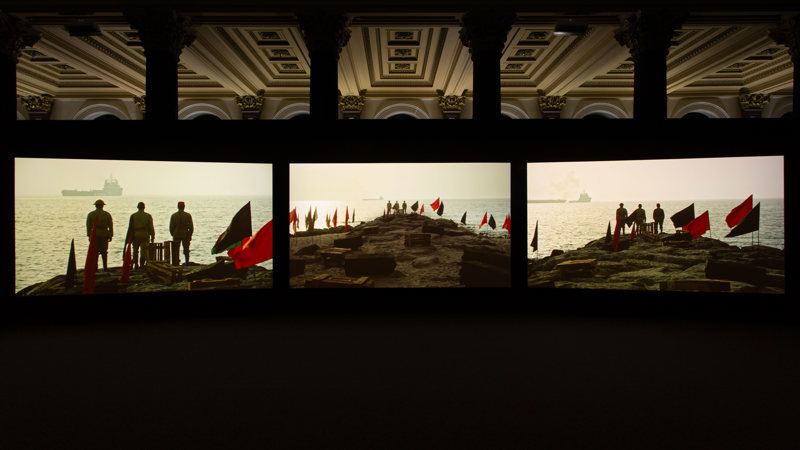
John Akomfrah Mimesis: African Soldier, 2018
Installed at the Gallery of Modern Art (GoMA), Glasgow, October 2024
© Smoking Dogs Films; Courtesy Smoking Dogs Films and Glasgow Life Museums.
Photo: Matthew Barnes
4th February 2025
In October 2024, during Black History Month, the Gallery of Modern Art, Glasgow (GoMA) opened the exhibition of John Akomfrah’s Mimesis: African Soldier in its main gallery space. Acquired for Glasgow Life Museums’ collection in 2019, the artwork is being shown in Scotland for the first time. Mimesis: African Soldier was originally commissioned as part of 14–18 NOW, a programme of events across the UK to commemorate the centenary of World War I, and was presented to Bristol Museum and Art Gallery and Glasgow Life Museums by Art Fund and 14–18 NOW.
Sir John Akomfrah, CBE, RA, was born in Ghana in 1957, but had to flee from there after the military coup in 1966 when his father was killed. He and his mother initially went to the USA and then later settled in London, where he now lives and works as an artist and filmmaker. He was a founding member of the influential Black Audio Film Collective, which started in London in 1982, alongside artists David Lawson and Lina Gopaul, who he still collaborates with today, together with his son Ashitey Akomfrah, as Smoking Dogs Films.
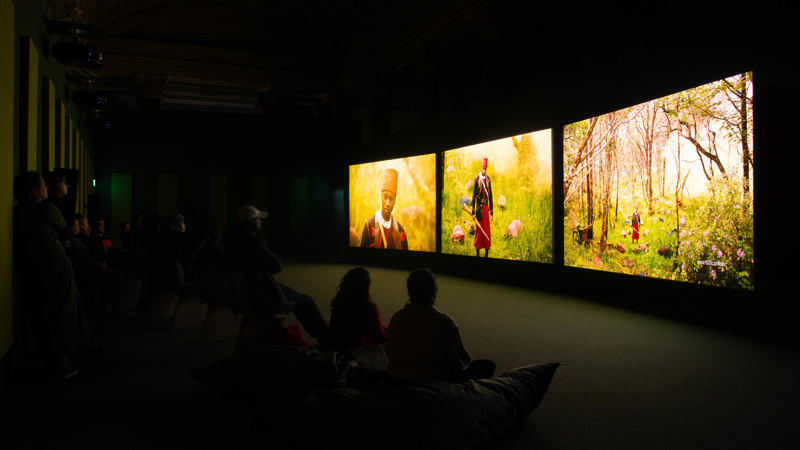
John Akomfrah Mimesis: African Soldier, 2018
Installed at the Gallery of Modern Art (GoMA), Glasgow, October 2024
© Smoking Dogs Films; Courtesy Smoking Dogs Films and Glasgow Life Museums.
Photo: Matthew Barnes
Akomfrah has worked in film for television, cinema and the museum or gallery space – moving between spaces where he felt the visibility of Black lives and experiences were missing from a contemporary Britain. In the 1980s he worked in TV, notably for Channel 4, and when the broadcast opportunities became limited for the types of experimental work he wanted to make, he went into cinematic film and gallery spaces. He is renowned worldwide, with shows across the globe and recently represented Great Britain at the Venice Biennale with his work Listening All Night to the Rain, which by all accounts is an amazing show (which will be coming to Dundee Contemporary Arts in 2026).
In the 1980s he attended the First National Black Art Convention, held at Wolverhampton Polytechnic in 1982, where he met other Black British artists and for the first time understood there were other Black British creatives out there. Many of those who attended have become increasingly well known, including Lubaina Himid (Turner Prize winner 2018), Marlene Smith (recently showed at The Glasgow School of Art, GSA), Claudette Johnson (nominated for the Turner Prize 2024) and Keith Piper (creator of the TATE Britain commission Viva Voce). As Akomfrah noted recently, ‘The loneliness and solitude that came with being a minority or a pariah-like figure in the 1980s has completely disappeared’. There is a sense of optimism because of the strength of community between him and his peers and also because of more recent generations of artists working today, like Alberta Whittle in Scotland.
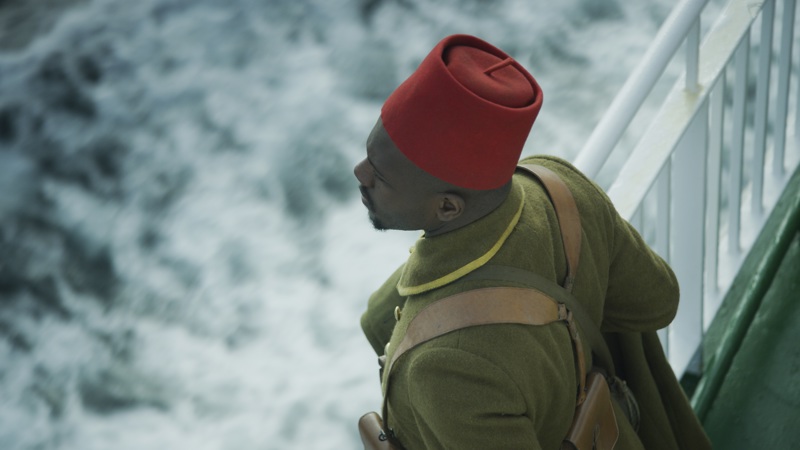
John Akomfrah Mimesis: African Soldier, 2018
Three channel HD colour video installation, 7.1 sound. Dimensions variable, 73 minutes
© Smoking Dogs Films; Courtesy Smoking Dogs Films and Lisson Gallery.
John Akomfrah’s artworks are monumental in scale and ambition. He is known for working with found footage alongside film footage he shoots on locations around the world (and he has a particular affection for the west coast of Scotland, which has appeared in works including Vertigo Sea and Mimesis). With this archival and contemporary footage, he creates an immersive and emotive collage. Soundscapes are hugely important to his film works – you can see that in Mimesis – and contribute to emotional connections and responses to what is unfolding on screen.
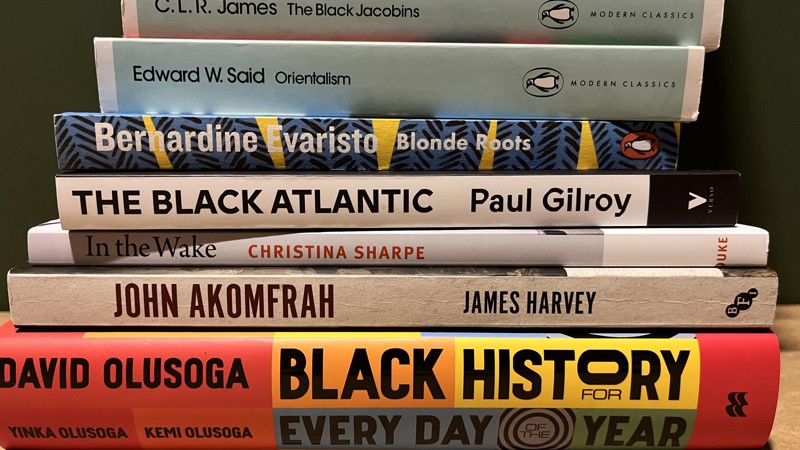
A collection of books from Akomfrah's reading list, linked to below
Image © CSG CIC Glasgow Museums Collection
For Mimesis: African Soldier, Akomfrah wanted to focus on what had hitherto been rendered, by all sides, a small story in the overall narrative of World War I, known as the Great War. Statements at the beginning of the artwork tell us that:
Six million African and other colonial subjects fought and served in The Great War
Over two million of them travelled to serve in Europe
Three hundred and fifty thousand of them will die in Europe
He was also interested in expanding the understanding of the war, and where it was fought – it was not all fought in Europe, but across the globe, drawing in allies, lands, resources and people from the African continent, South Asia, the Caribbean and the Middle East.
So, by including the documentary footage that shows this and creating new footage with actors that humanises a story we know through statistics, Mimesis explores this history, in a collage across the three screens. There is no spoken narrative, instead there are poignant quotations and an emotive soundscape including song. Words appear on the screens to function as pauses or titles to the powerful images and archive film that we are witnessing. These words encapsulate what we are seeing unfold before us, echoing the soldiers’ journeys and conscription into a war that was not of their making. It is also a journey for those individuals who relate to generational experiences and independence movements across the former colonies of the British Empire of the twentieth century. The work’s subtitle is ‘The ambiguities of colonial disenchantment’.
Our understanding of this disenchantment develops as the artwork progresses. Visual imagery and the ‘titles’ or pauses in the film help us understand what Akomfrah is trying to get across – a complex, mixed sense of love, duty, hate and resistance that comes with any war, and a sense of what those involved on both sides are fighting for: freedom and change. On returning home, there would be no evidence of this for those conscripts from across the colonies who survived the war. This led to more active resistance, disillusionment with the colonial status quo and later independence movements, alluded to in the film with the inclusion of the red, black and green Pan-African flag.
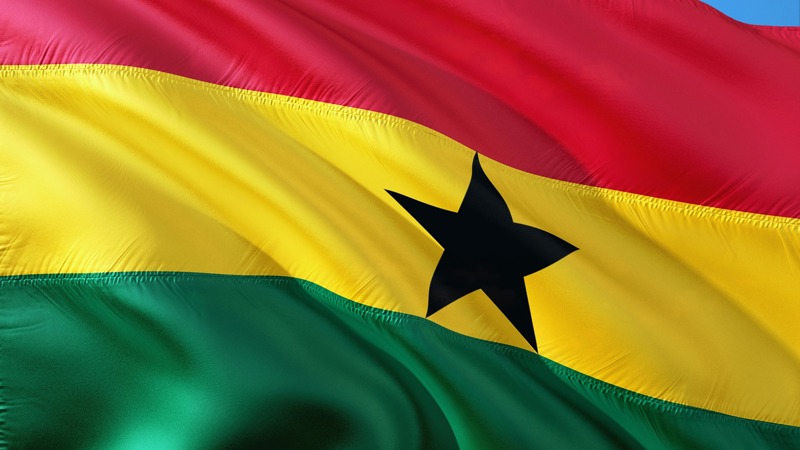
Ghanian Flag
The present-day flag for Ghana incorporates the Pan-African colours of red, yellow, green and black.
While this is a sad, moving and at times difficult artwork to watch, there is – like a lot of John Akomfrah’s work – a feeling in it of change and the articulated presence of the Black voice in history.
Mimesis: African Soldier will be on display in GoMA until January 2026. We are very grateful to John and Smoking Dogs Films for providing us with a reading list of publications – historical, fiction, poetry and exhibitions – that relate to his work and practice. We have also added some books that are important to ongoing work on our displays and collections across Glasgow Life Museums. Some of these books are available in exhibition spaces across GoMA or in Library at GoMA. To access the reading list for John Akomfrah’s Mimesis: African Soldier, please click here.
